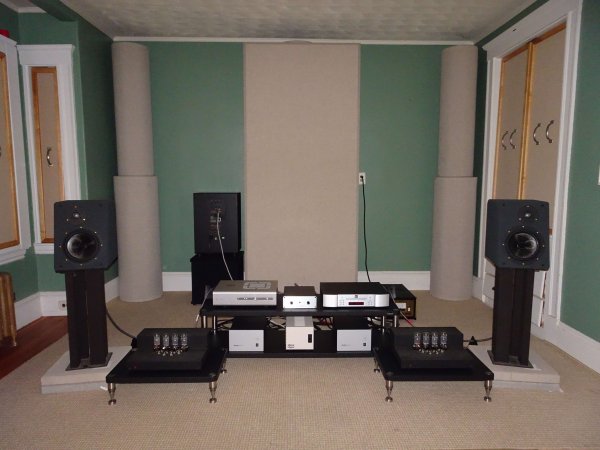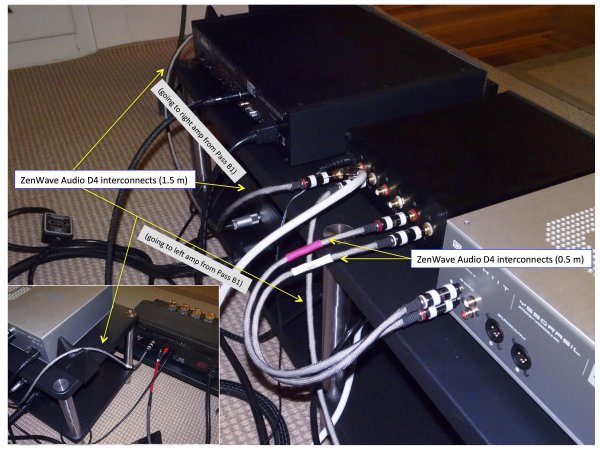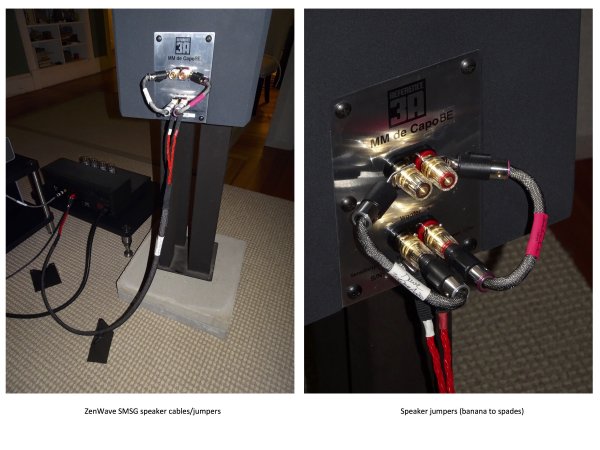On Wednesday evening I visited Al and heard his system. I can't recall the last time I was there but it had been a while (several months?).
Al, I was not prepared for how good your system sounded. From the first xylophone (or was it a marimba, I can't remember) of the James Bond CD I could tell there was amazing body and the horns that followed confirmed it very quickly. Of course there was also a great sense of space (which I did expect based on previous visits) but the cleanliness of the sound was vastly improved since the last time I was there. Certainly you had made changes: the large angled panel at the front of the room in front of your tube traps, the new amp and equipment racks and DaveC's Zenwave Audio cable to list the obvious ones.
The low end, when it occasionally appeared in the James Bond music, was intoxicating. The imaging was also great (confirmed by the most convincing phase effects I have ever heard; not only did they go off to the sides but behind me and to the ceiling at times). Bravo.
When we heard the Janaki Trio I was shocked at how different it sounded compared to my system. For a moment I thought the timbre was a little colored, but I quickly put that out of my mind and was blown away by the immediacy of the presentation and how much it felt like the performers were right there in the room. It was the closest thing to hearing live cello and violin based on what I heard at the Ayer Mansion last fall. Vocals were equally impressive in terms of body and presence.
Speaking of body, I don't know how you get so much body, let alone without any muddiness in the lower region. And of course without any softness or lack of detail. The term 'phat' comes to mind. Tuba and the lower registers of a cello are startlingly realistic.
Again - bravo. Your system should be heard by every audiophile who thinks they need to spend hundreds of thousands of dollars to put together a reference system.
Al, I was not prepared for how good your system sounded. From the first xylophone (or was it a marimba, I can't remember) of the James Bond CD I could tell there was amazing body and the horns that followed confirmed it very quickly. Of course there was also a great sense of space (which I did expect based on previous visits) but the cleanliness of the sound was vastly improved since the last time I was there. Certainly you had made changes: the large angled panel at the front of the room in front of your tube traps, the new amp and equipment racks and DaveC's Zenwave Audio cable to list the obvious ones.
The low end, when it occasionally appeared in the James Bond music, was intoxicating. The imaging was also great (confirmed by the most convincing phase effects I have ever heard; not only did they go off to the sides but behind me and to the ceiling at times). Bravo.
When we heard the Janaki Trio I was shocked at how different it sounded compared to my system. For a moment I thought the timbre was a little colored, but I quickly put that out of my mind and was blown away by the immediacy of the presentation and how much it felt like the performers were right there in the room. It was the closest thing to hearing live cello and violin based on what I heard at the Ayer Mansion last fall. Vocals were equally impressive in terms of body and presence.
Speaking of body, I don't know how you get so much body, let alone without any muddiness in the lower region. And of course without any softness or lack of detail. The term 'phat' comes to mind. Tuba and the lower registers of a cello are startlingly realistic.
Again - bravo. Your system should be heard by every audiophile who thinks they need to spend hundreds of thousands of dollars to put together a reference system.





